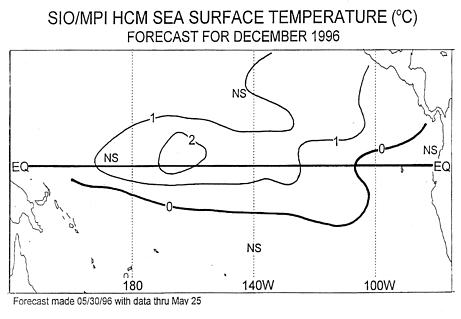
[Previous Article]
[Next Article]
Dynamically Based Forecasts for Tropical Pacific
SST for December 1996 Using a Hybrid Coupled Ocean/Atmospheric Model
contributed by Tim Barnett1, Nicholas Graham1
and Mojib Latif 2
1Scripps Institution of Oceanography, La Jolla, California
2Max Planck Institut fur Meteorologie,
Hamburg, Germany
In several issues of this Bulletin (e.g. March and June
of 1994, September 1995), we introduced forecasts of the tropical Pacific
SST using a hybrid coupled oceanatmosphere model (HCM) developed jointly
at Scripps Institution and the Max Planck Institute for Meteorology (MPI)
(Barnett et al. 1993). The ocean model, created at MPI (Latif 1987), is
a fully nonlinear GCM bounded by 30oN and 30oS latitude
and by Asia and South America. It has 13 vertical levels, 10 of which are
within the top 300 m. The seasonal cycle is governed by a Newtonian heat
flux and observed wind stress (Goldenberg and O'Brien 1981). The vertical
mixing scheme is dependent upon the Richardson number (Pacanowski and Philander
1981). The atmospheric model is statistical, deriving the wind stress forcing
for the ocean GCM using the GCM's SST. This is done with a CCAlike regression
model, using historical observed data fields of anomalous SST and the corresponding
wind stress. The coupling process includes a MOSlike statistical correction
of the SST fields produced by the ocean GCM. The hybrid coupled model is
initialized with wind stress fields derived from observed SST data; thus,
it is indirectly "spun up" with SST information. Considering
the entire 196593 period, the model has demonstrated statistically significant
predictive skill out to 12 to 18 months, with best performance for the
central equatorial Pacific and for winter forecasts (Barnett et al. 1993,
and the March 1994 issue of this Bulletin show the skill distribution).
The model was constructed using data from the 196585 period, leaving 1986
and later for independent forecasting. Partly because of the MOS correction
scheme, there is no need for bias correction. However, a temporal phase
postprocessor is applied to the forecasts as a function of their lead time.
Figure 1 shows the HCM forecast of tropical Pacific SST
anomaly field for December 1996, using data through most of May 1996. It
suggests that the currently slightly below normal SST along the equator
in the eastern half of the basin will warm considerably by early winter,
especially in the central region where a 2EC anomaly is forecast. The historical
skill in this part of the equatorial Pacific is comparatively good, lending
some confidence to the warming trend. The model has been forecasting warming
in some form (i.e. varying in exact location, timing and intensity) for
winter 1996-97 for the last 10 months, which might be regarded as an additional
indication of reliability.
Caveat: The forecasts shown above are experimental in
nature. The reader is forewarned that the methods/forecasts are very new
and subject to future change and improvement.
Acknowledgment: This work is supported by NOAA and the
National Science Foundation's Climate Dynamics Division.
Barnett, T.P., M. Latif, N. Graham, M. Flugel, S. Pazan
and W. White, 1993: ENSO and ENSOrelated predictability: Part 1 Prediction
of equatorial Pacific sea surface temperatures with a hybrid coupled oceanatmosphere
model. J. Climate, 6, 15451566.
Goldenberg, S.D. and J.J. O'Brien, 1981: Time and space variability of tropical Pacific wind stress. Mon. Wea. Rev., 109, 11901207.
Latif, M., 1987: Tropical ocean circulation experiments.
J. Phys. Oceanogr., 17, 246263.
Pacanowski, R.C. and S.G.H. Philander, 1981: Parameterization
of vertical mixing in numerical models of tropical oceans. J. Phys.
Oceanogr., 11, 1443-1451.

Fig. 1. Scripps/MPI hybrid coupled model forecast
of the field of tropical Pacific SST anomaly (oC) for December,
1996. Data up to May 25 are used.